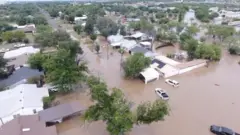Texas Flood Tragedy: Examining the Early Warnings and Preparedness
Central Texas is grappling with the devastating aftermath of flash floods that have tragically claimed the lives of nearly 80 people, with officials cautioning that the death toll is likely to rise as rescue operations continue. The sheer scale of the disaster, which inundated vast areas and tragically swept away 28 children in Kerr County, has ignited a critical examination of the warning systems and evacuation procedures that were in place.
The community of Kerrville and surrounding areas experienced a catastrophic deluge, with the Guadalupe River experiencing an unprecedented rise of 26 feet in just 45 minutes. This rapid escalation of floodwaters overwhelmed many, prompting urgent questions about whether residents received timely and sufficient warnings.
Flood Warnings and Timeline of Events
The sequence of events leading up to and during the floods highlights a critical timeline of issued warnings:
- Wednesday: The Texas Division of Emergency Management (TDEM) proactively activated state emergency response resources in anticipation of increased flood threats in West and Central Texas.
- Thursday Afternoon: The National Weather Service (NWS) issued a Flood Watch, specifically identifying Kerr County as an area at high risk for flash flooding overnight.
- Friday, 01:14 Local Time (06:14 GMT): A Flash Flood Warning was officially issued for Kerr County.
- Friday, 04:03 Local Time (09:30 GMT): An emergency Flash Flood Warning was issued for Kerr County, followed by another for the Guadalupe River at 05:34.
Accountability and Preparedness: A Closer Look
In the wake of the tragedy, officials have been pressed on the effectiveness of the warning systems. Governor Greg Abbott commented that while Texans are accustomed to flood warnings, the sheer magnitude of this event, described as a “water wall of almost 30ft high,” was beyond typical expectations.
Nim Kidd, chief of the Texas Division of Emergency Management, pointed to challenges in areas with limited or no cell phone coverage, stating that even with alert systems, effective notification can be compromised. The city manager of Kerrville, Dalton Rice, noted that the public can sometimes become desensitized to frequent warnings. He recounted his personal experience of witnessing the rapid rise of the Guadalupe River firsthand, noting how quickly the situation escalated from a light rain to a dangerous flood in a matter of hours.
Concerns have also been raised regarding the absence of a county-administered, dedicated flood warning system in Kerr County. It was revealed that approximately six years prior, the county had considered implementing a siren system, similar to those used for tornadoes, but the significant cost precluded its implementation. The National Weather Service defended its actions, stating that they issued timely forecasts and warnings, providing lead times of over three hours before warning criteria were met. However, some experts, speaking to The New York Times, suggested that the forecasts, while as accurate as possible given the extreme rainfall and abrupt escalation, could potentially have been enhanced with better resources.
The Impact of Budget Cuts on Weather Services
Discussions have emerged regarding the potential impact of budget cuts on the National Weather Service (NWS) and its parent agency, the National Oceanic and Atmospheric Administration (NOAA). Reports indicate concerns over budget reductions affecting weather research laboratories and a decrease in the number of weather balloons used for atmospheric observation, which are crucial for forecasting accuracy. Some experts have questioned whether staffing shortages within the NWS may have hindered coordination with local emergency managers during the crisis. Conversely, representatives from the NWS Employees Organization and the NWS office serving Central Texas have stated that the relevant offices were adequately staffed and equipped to issue timely warnings, with the local office even having additional personnel on duty during the storms.
Government Response and Future Preparedness
In response to questions about the government’s role and preparedness, US Homeland Security Secretary Kristi Noem acknowledged the inherent difficulties in predicting weather events but emphasized President Trump’s commitment to modernizing the nation’s weather warning systems. She assured that concerns regarding NWS resources would be conveyed to the federal government, noting that while the NWS has historically performed well, there is a universal desire for enhanced warning times through technological upgrades. The administration has prioritized updating the technology, with ongoing reforms aimed at addressing long-neglected systems. President Trump is reportedly planning a visit to the affected area.

